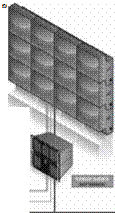Graphics wall controllers (Figure 4.36) enable operators and other employees with diverse interconnected responsibilities to share a common view of images from different kinds of information sources. These sources can be remote video cameras, TV signals, workstations, and PCs, or proprietary applications. Used together with projectors, projection cubes, and other display devices, the controller then creates a huge desktop on this matrix of displays. The connected sources to the controller such as digital visual interface (DVI), RGB (red, green, and blue), or video can be inserted and placed on the video wall as required by the control room employees. So the fundamental question here with regards to choosing the appropriate controller is what has to be displayed (Figure 4.37).
Video Sources: TV signals, normally available as analogue signals (composite, S-Video, or Y/C).[12] This signal comes from a TV tuner, VCR or DVD player, video teleconferencing system, or closed-circuit television (CCTV) cameras. Some control rooms require only one video signal, for example, a weather forecast channel. Other applications such as traffic control or security need hundreds of video sources. Other important points here are how many sources have to be displayed simultaneously, how many in a single display, and whether the images have to be increased in scale or downscaled and by what rate.
RGB or DVI Sources: These are signals that are in general progressively scanned and do not follow TV standards. That means the complete image is refreshed in a single pass and not interlaced. Typical RGB or DVI sources are computer outputs (from VGA to UXGA). RGB or DVI sources can be captured and shown as a window on the large screen wall. These computer signals can be increased in scale and displayed on the complete large screen wall for a better overview (in general, for grid overviews for energy distribution). For these computer sources it is important that a
 |
 |
LAN
• ^pUcaUoff Application ^
Server (X11) Server (WIA) IP Video Client Workstations
FIGURE 4.37 Schematic representation of a large screen.
high-end controller with graphic cards is used with which RGB or DVI sources are displayed in real time without any time lag or delay.
Applications Directly on the Controller: Nowadays these controllers are based on the latest hardware PC technology and are very compatible with operating systems based on Windows or Linux, which makes it possible to run the customer applications directly on the controller and display it on the large screen wall. Here the main questions are whether compatibility with the operating system is given, and if there is sufficient central processing unit (CPU) and storage capacity.
Network Applications: Network applications can be connected very easily onto the controllers, because standard graphics controllers are equipped with one or several LAN inputs (standard 1 Gb). Also, the operating compatibility is the most important point.
Capture Sources from Network: Some vendors provide special management software for their controllers to enable the capture of sources in the network. It is unimportant whether these sources are from Unix, Linux, Windows, or elsewhere. Through the network they can be displayed on the large screen system. In that way it is also possible to operate one PC from a remote PC via the network.
In many control rooms, several operating systems (OS) are available such as Microsoft Windows and Unix/Linux at the same time. To provide compatibility, most systems use an X window system. For controllers using Linux OS, an X window user interface will be used and the X applications from other workstations can be easily displayed on the large screen system. But for Windows-based applications the display possibilities are limited. At present, most (approximately 98%) of graphics
controllers in control rooms are Windows based. If the graphics controller is Windows based, the compatibility with other Windows systems in the network will be excellent. If the controller is equipped with an X server interface, there is also compatibility with Linux, Unix, Solaris, and other systems.
Streaming Video: This modern technology is growing very quickly. Streaming video are video sources over IP. These are generally in a low resolution (maximum 320×240); the standards are, for example, MPEG1-4, MJPEG. This means that these sources have to be scaled up to larger window sizes to be large enough to control them on the large screen system. Nowadays the controllers also have the possibility to build-in IP decoder boards.



